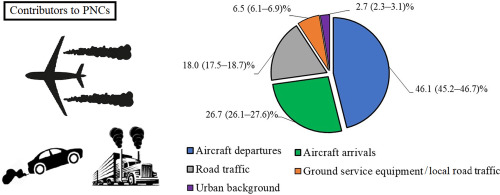Environmental Pollution ( IF 8.9 ) Pub Date : 2020-01-25 , DOI: 10.1016/j.envpol.2020.114027 Milad Pirhadi 1 , Amirhosein Mousavi 1 , Mohammad H Sowlat 1 , Nicole A H Janssen 2 , Flemming R Cassee 3 , Constantinos Sioutas 1

|
In this study, the positive matrix factorization (PMF) source apportionment model was employed to quantify the contributions of airport activities to particle number concentrations (PNCs) at Amsterdam Schiphol. Time-resolved particle number size distributions in parallel with the concentrations of auxiliary variables, including gaseous pollutants (NOx and CO), black carbon, PM2.5 mass, and number of arrivals/departures were measured for 32 sampling days over a 6-month period near Schiphol airport to be used in the model. PMF results revealed that airport activities, cumulatively, accounted for around 79.3% of PNCs and our model segregated them into three major groups: (i) aircraft departures, (ii) aircraft arrivals, and (iii) ground service equipment (GSE) (with some contributions of local road traffic, mostly from airport parking lots). Aircraft departures and aircraft arrivals showed mode diameters <20 nm and contributed, respectively, to 46.1% and 26.7% of PNCs. The factor GSE/local road traffic, with a mode diameter of around 60–80 nm, accounted for 6.5% of the PNCs. Road traffic related mainly to the surrounding freeways was characterized with a mode diameter of 30–40 nm; this factor contributed to 18.0% of PNCs although its absolute PNCs was comparable with that of areas heavily impacted by traffic emissions. Lastly, urban background with a mode diameter at 150–225 nm, had a minimal contribution (2.7%) to PNCs while dominating the particle volume/mass concentrations with a contribution of 58.2%. These findings illustrate the dominant role of the airport activities in ambient PNCs in the surrounding areas. More importantly, the quantification of the contributions of different airport activities to PNCs is a useful tool to better control and limit the increased PNCs near the airports that could adversely impact the health of the adjacent urban communities.
中文翻译:

大型国际机场活动和其他城市资源对附近监测点的粒子数浓度(PNC)的相对贡献。
在这项研究中,正矩阵分解(PMF)源分配模型用于量化阿姆斯特丹史基浦机场活动对粒子数浓度(PNC)的贡献。时间分辨的粒径分布与辅助变量的浓度平行,包括气体污染物(NO x和CO),黑碳,PM 2.5在模型中使用的史基浦机场附近,在6个月内对32个采样日的质量和到达/离开的数量进行了测量。PMF结果显示,机场活动累计占PNC的约79.3%,我们的模型将其分为三大类:(i)飞机离场,(ii)飞机进场和(iii)地面服务设备(GSE)(包括当地道路交通的一些贡献,大部分来自机场停车场)。飞机起降和飞机进港的模式直径小于20 nm,分别占PNC的46.1%和26.7%。模式直径在60–80 nm左右的GSE /本地道路交通因素占PNC的6.5%。道路交通主要与周围的高速公路有关,其模式直径为30-40 nm。这个因素贡献了18。尽管其绝对PNC与受交通排放严重影响的地区的绝对PNC相当,但仍有0%的PNC。最后,具有150-225 nm众数直径的城市背景对PNC的贡献最小(2.7%),而占颗粒体积/质量浓度的主要部分为58.2%。这些发现说明了机场活动在周边地区周围PNC中的主导作用。更重要的是,量化不同机场活动对PNC的贡献是一种有用的工具,可以更好地控制和限制机场附近增加的PNC,这可能会对邻近城市社区的健康产生不利影响。PNC占7%),而颗粒体积/质量浓度占58.2%,占主导地位。这些发现说明了机场活动在周围地区周围PNC中的主导作用。更重要的是,量化不同机场活动对PNC的贡献是一种有用的工具,可以更好地控制和限制在机场附近增加的PNC,这可能会对邻近城市社区的健康产生不利影响。PNC占7%),而颗粒体积/质量浓度占58.2%,占主导地位。这些发现说明了机场活动在周围地区周围PNC中的主导作用。更重要的是,量化不同机场活动对PNC的贡献是一种有用的工具,可以更好地控制和限制在机场附近增加的PNC,这可能会对邻近城市社区的健康产生不利影响。



























 京公网安备 11010802027423号
京公网安备 11010802027423号